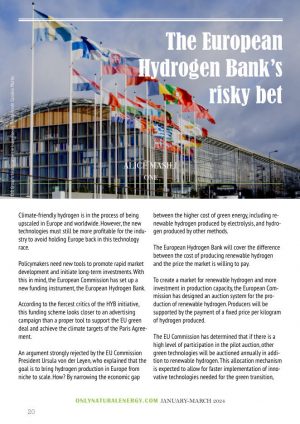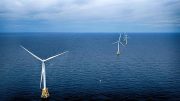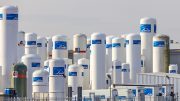 Climate-friendly hydrogen is in the process of being upscaled in Europe and worldwide. However, the new technologies must still be more profitable for the industry to avoid holding Europe back in this technology race.
Climate-friendly hydrogen is in the process of being upscaled in Europe and worldwide. However, the new technologies must still be more profitable for the industry to avoid holding Europe back in this technology race.
Policymakers need new tools to promote rapid market development and initiate long-term investments. With this in mind, the European Commission has set up a new funding instrument, the European Hydrogen Bank.
According to the fiercest critics of the HYB initiative, this funding scheme looks closer to an advertising campaign than a proper tool to support the EU green deal and achieve the climate targets of the Paris Agreement.
An argument strongly rejected by the EU Commission President Ursula von der Leyen, who explained that the goal is to bring hydrogen production in Europe from niche to scale. How? By narrowing the economic gap between the higher cost of green energy, including renewable hydrogen produced by electrolysis, and hydrogen produced by other methods.
The European Hydrogen Bank will cover the difference between the cost of producing renewable hydrogen and the price the market is willing to pay.
To create a market for renewable hydrogen and more investment in production capacity, the European Commission has designed an auction system for the production of renewable hydrogen. Producers will be supported by the payment of a fixed price per kilogram of hydrogen produced.
The EU Commission has determined that if there is a high level of participation in the pilot auction, other green technologies will be auctioned annually in addition to renewable hydrogen. This allocation mechanism is expected to allow for faster implementation of innovative technologies needed for the green transition, especially in hard-to-abate sectors.
The first auction for the production of green hydrogen was opened last November, and up to 800 million euros were awarded to producers of renewable hydrogen.
Under the pilot auction, producers of renewable hydrogen within the meaning of the Renewable Energy Directive and the corresponding delegated acts can bid for EU funding for a certain amount of hydrogen production. Bids must be based on a proposed increase in the price per kilogram of renewable hydrogen produced, which may not exceed €4.5/kg.
Bids below this cap and meet the other eligibility requirements will be ranked in ascending order of price. They will receive funding in that order until the auction quota is exhausted. The selected projects will receive grants and the proceeds from selling hydrogen on the market for ten years—no more than that. Once the grant agreements are signed, renewable hydrogen production must start within five years.
Cumulation with any other aid is excluded to ensure a level playing field for all projects, regardless of location. This will avoid fragmentation of the European hydrogen market in the initial phase and reduce administrative costs for future national mechanisms to promote this type of energy. Auction participants can apply until February 8, 2024. The results of the evaluation will be available as early as April 2024.
This pilot auction will allow the Commission to collect reliable data on the development of renewable hydrogen projects in the EU, the level of competition for this type of support, production costs and the market price. This information will help plan future auctions for other decarbonisation products and technologies. A second round of auctions is expected in 2024.
The Centers for European Policy Network (CEP), which specialises in analysing EU regulations, has come out in favour of a European Hydrogen Bank following an in-depth analysis. However, the conditions currently laid down for the planned “pilot auction” also entail the risk of excessive public subsidisation, which could hinder the principle of healthy competition.
The small number of participants restricts competition, and the “pay-as-bid” procedure creates incentives for strategic bidding so that bids are likely close to the
maximum limit.
According to Andrè Wolf, an expert on new technologies at CEP, who has analysed the EU plans, “there is a risk of over-subsidising producers that are already efficient in large-scale hydrogen production and promoting electrolysis in regions with less favourable conditions for renewable energy”.
To counter this risk, the expected maximum subsidy rate should be significantly reduced. Andrè Wolf states, “The restrictions on participation in auctions should be relaxed to increase competition. This applies to the minimum size of electrolysis capacities, so small producers can also benefit from the funding”.
By accelerating the introduction of innovative hydrogen technologies, the pilot auction will help to achieve the REPowerEu plan’s target of producing 10 million tonnes of renewable hydrogen domestically and importing a further 10 million tonnes of hydrogen by 2030.
This is a target forced by the energy crisis that followed the Russian invasion of Ukraine, which has demonstrated the EU’s dependence on fossil fuels and Russian natural gas.
That energy crisis has forced the European Commission to lower the sustainability criteria for “green” hydrogen. A greater flexibility that leads to the promotion of electrolysis for the supply of hydrogen, even if this is not possible with renewable sources.
In the Commission’s view this is a temporary measure to tackle both the climate and energy crisis, but it is a risky one as it can have the boomerang effect of prolonging dependence on fossil fuels and increasing the costs. Simply put it’s exactly the opposite result. This is because the production of hydrogen requires a lot of energy and the production of green hydrogen requires a lot of renewable energy.
It is mandatory to promote the expansion of renewable energies as well as the hydrogen market. One without the other would bring recession.
Alice Masili





